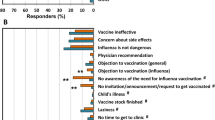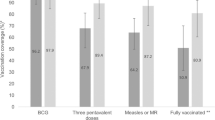Abstract
The Advisory Committee on Immunization Practices (ACIP) recommends that certain children under 9 years of age receive two influenza vaccine doses in a season for optimal protection. Recent data indicate that many of these children fail to receive one or both of these needed doses. Contributing factors to under-vaccination of this population remain unclear. Caregivers of children aged 6 months–8 years requiring two influenza vaccine doses in the 2010–2011 season were identified from households enrolled in four urban Head Start programs. Recruitment and survey administration were conducted between March and June 2011. The impact of caregiver, provider, and practice-based factors on influenza vaccine receipt was assessed using bivariate and multivariable logistic regression analyses. Caregivers (n = 128) were predominantly mothers, Latina, Spanish-speaking, and non-U.S. born. Few children received one (31 %) or both (7 %) influenza vaccine doses. Caregivers who discussed influenza vaccination with providers were more likely to know their child needed two doses (55 vs. 35 %, p < 0.05) and have a fully vaccinated child (11 vs. 0 %, p < 0.05). Among caregivers whose child received the first dose, those who reported being told when to return for the second dose were also more likely to have a fully vaccinated child (35 vs. 0 %, p = 0.05). Belief in influenza vaccine effectiveness was positively associated with vaccination (p < 0.001), while safety concerns were negatively associated (p < 0.05). This study highlights the importance of provider-family communication about the two-dose regimen as well as influenza vaccine effectiveness and safety.
Similar content being viewed by others
References
Fiore, A. E., Uyeki, T. M., Broder, K., et al. (2010). Prevention and control of influenza with vaccines: Recommendations of the Advisory Committee on Immunization Practices (ACIP), 2010. MMWR Recommendation Report, 59(RR-8), 1–62.
Hofstetter, A. M., Natarajan, K., Martinez, R. A., Rabinowitz, D., Vawdrey, D. K., & Stockwell, M. S. (2013). Influenza vaccination coverage and timeliness among children requiring two doses, 2004–2009. Preventive Medicine, 56(3–4), 165–170.
Bhatt, P., Block, S. L., Toback, S. L., & Ambrose, C. S. (2011). Timing of the availability and administration of influenza vaccine through the vaccines for children program. The Pediatric Infectious Disease Journal, 30(2), 100–106.
Jackson, L. A., Neuzil, K. M., Baggs, J., et al. (2006). Compliance with the recommendations for 2 doses of trivalent inactivated influenza vaccine in children less than 9 years of age receiving influenza vaccine for the first time: A Vaccine Safety Datalink study. Pediatrics, 118(5), 2032–2037.
Pabst, L. J., Fiore, A. E., & Cullen, K. A. (2011). Completion of the 2-dose influenza vaccine series among children aged 6 to 59 months: Immunization information system sentinel sites, 2007–2008 influenza season. Clinical Pediatrics (Philadelphia), 50(11), 1068–1070.
Pabst, L. J., Chaves, S. S., & Weinbaum, C. (2013). Trends in compliance with two-dose influenza vaccine recommendations among children aged 6 months through 8 years. Vaccine, 31(31), 3116–3120.
Hofstetter, A. M., Natarajan, K., Rabinowitz, D., et al. (2013). Timeliness of pediatric influenza vaccination compared to seasonal influenza activity in an urban underserved community, 2004–2008. American Journal of Public Health, 103(7), e50–e58.
Uwemedimo, O. T., Findley, S. E., Andres, R., Irigoyen, M., & Stockwell, M. S. (2012). Determinants of influenza vaccination among young children in an inner-city community. Journal of Community Health, 37(3), 663–672.
Cohen, B., Ferng, Y. H., Wong-McLoughlin, J., Jia, H., Morse, S. S., & Larson, E. L. (2012). Predictors of flu vaccination among urban Hispanic children and adults. Journal of Epidemiology and Community Health, 66(3), 204–209.
Daley, M. F., Crane, L. A., Chandramouli, V., et al. (2006). Influenza among healthy young children: Changes in parental attitudes and predictors of immunization during the 2003 to 2004 influenza season. Pediatrics, 117(2), e268–e277.
Grant, V. J., Le Saux, N., Plint, A. C., et al. (2003). Factors influencing childhood influenza immunization. CMAJ, 168(1), 39–41.
Lin, C. J., Zimmerman, R. K., Nowalk, M. P., et al. (2006). Parental perspectives on influenza vaccination of children with chronic medical conditions. Journal of the National Medical Association, 98(2), 148–153.
Nowalk, M. P., Zimmerman, R. K., Lin, C. J., et al. (2005). Parental perspectives on influenza immunization of children aged 6 to 23 months. American Journal of Preventive Medicine, 29(3), 210–214.
Humiston, S. G., Lerner, E. B., Hepworth, E., Blythe, T., & Goepp, J. G. (2005). Parent opinions about universal influenza vaccination for infants and toddlers. Archives of Pediatrics and Adolescent Medicine, 159(2), 108–112.
Metroka, A. E., Hansen, M. A., Papadouka, V., & Zucker, J. R. (2009). Using an immunization information system to improve accountability for vaccines distributed through the Vaccines for Children program in New York City, 2005–2008. Journal of Public Health Management and Practice, 15(5), E13–E21.
New York State Department of Health. (2011). New York State Department of Health 2010–2011 flu monitoring—Week ending May 21, 2011. http://www.health.ny.gov/diseases/communicable/influenza/surveillance/2010-2011/archive/2011-05-21/. Accessed 9 June 2014.
Dee, D. L., Bensyl, D. M., Gindler, J., et al. (2011). Racial and ethnic disparities in hospitalizations and deaths associated with 2009 pandemic Influenza A (H1N1) virus infections in the United States. Annals of Epidemiology, 21(8), 623–630.
Quinn, S. C., Kumar, S., Freimuth, V. S., Musa, D., Casteneda-Angarita, N., & Kidwell, K. (2011). Racial disparities in exposure, susceptibility, and access to health care in the US H1N1 influenza pandemic. American Journal of Public Health, 101(2), 285–293.
Dominguez, S. R., & Daum, R. S. (2005). Physician knowledge and perspectives regarding influenza and influenza vaccination. Human Vaccines, 1(2), 74–79.
Larson, E., Ferng, Y. H., Wong, J., et al. (2009). Knowledge and misconceptions regarding upper respiratory infections and influenza among urban Hispanic households: Need for targeted messaging. Journal of Immigrant and Minority Health, 11(2), 71–82.
Wooten, K. G., Wortley, P. M., Singleton, J. A., & Euler, G. L. (2012). Perceptions matter: Beliefs about influenza vaccine and vaccination behavior among elderly white, black and Hispanic Americans. Vaccine, 30(48), 6927–6934.
Freed, G. L., Clark, S. J., Butchart, A. T., Singer, D. C., & Davis, M. M. (2010). Parental vaccine safety concerns in 2009. Pediatrics, 125(4), 654–659.
Shui, I. M., Weintraub, E. S., & Gust, D. A. (2006). Parents concerned about vaccine safety: Differences in race/ethnicity and attitudes. American Journal of Preventive Medicine, 31(3), 244–251.
Darden, P. M., Thompson, D. M., Roberts, J. R., et al. (2013). Reasons for not vaccinating adolescents: National Immunization Survey of Teens, 2008–2010. Pediatrics, 131(4), 645–651.
Freed, G. L., Clark, S. J., Butchart, A. T., Singer, D. C., & Davis, M. M. (2011). Sources and perceived credibility of vaccine-safety information for parents. Pediatrics, 127(Suppl 1), S107–S112.
Stockwell, M. S., Irigoyen, M., Andres Martinez, R., & Findley, S. E. (2014). Failure to return: Parental, practice, and social factors affecting missed immunization visits for urban children. Clinical Pediatrics (Philadelphia), 53(5), 420–427.
Smith, P. J., Santoli, J. M., Chu, S. Y., Ochoa, D. Q., & Rodewald, L. E. (2005). The association between having a medical home and vaccination coverage among children eligible for the vaccines for children program. Pediatrics, 116(1), 130–139.
Szilagyi, P. G., Rand, C. M., McLaurin, J., et al. (2008). Delivering adolescent vaccinations in the medical home: A new era? Pediatrics, 121(Suppl 1), S15–S24.
Rand, C. M., Szilagyi, P. G., Yoo, B. K., Auinger, P., Albertin, C., & Coleman, M. S. (2008). Additional visit burden for universal influenza vaccination of US school-aged children and adolescents. Archives of Pediatrics and Adolescent Medicine, 162(11), 1048–1055.
Stockwell, M. S., & Fiks, A. G. (2013). Utilizing health information technology to improve vaccine communication and coverage. Human Vaccines & Immunotherapeutics, 9(8), 1802–1811.
Vawdrey, D. K., Natarajan, K., Kanter, A. S., Hripcsak, G., Kuperman, G. J., & Stockwell, M. S. (2013). Informatics lessons from using a novel immunization information system. Studies in Health Technology and Informatics, 192, 589–593.
Birmingham, E., Catallozzi, M., Findley, S. E., Vawdrey, D. K., Kukafka, R., & Stockwell, M. S. (2011). FluAlert: A qualitative evaluation of providers’ desired characteristics and concerns regarding computerized influenza vaccination alerts. Preventive Medicine, 52(3–4), 274–277.
Fiks, A. G., Grundmeier, R. W., Biggs, L. M., Localio, A. R., & Alessandrini, E. A. (2007). Impact of clinical alerts within an electronic health record on routine childhood immunization in an urban pediatric population. Pediatrics, 120(4), 707–714.
Stockwell, M. S., Kharbanda, E. O., Martinez, R. A., Vargas, C. Y., Vawdrey, D. K., & Camargo, S. (2012). Effect of a text messaging intervention on influenza vaccination in an urban, low-income pediatric and adolescent population: A randomized controlled trial. JAMA, 307(16), 1702–1708.
Daley, M. F., Steiner, J. F., Brayden, R. M., Xu, S., Morrison, S., & Kempe, A. (2002). Immunization registry-based recall for a new vaccine. Ambulatory Pediatrics, 2(6), 438–443.
Irigoyen, M. M., Findley, S., Wang, D., et al. (2006). Challenges and successes of immunization registry reminders at inner-city practices. Ambulatory Pediatrics, 6(2), 100–104.
LeBaron, C. W., Starnes, D. M., & Rask, K. J. (2004). The impact of reminder-recall interventions on low vaccination coverage in an inner-city population. Archives of Pediatrics and Adolescent Medicine, 158(3), 255–261.
Hofstetter, A. M., Vargas, C. Y., Kennedy, A., Kitayama, K., & Stockwell, M. S. (2013). Parental and provider preferences and concerns regarding text message reminder/recall for early childhood vaccinations. Preventive Medicine, 57(2), 75–80.
Acknowledgments
We thank the ACURI Study Team, particularly Dulce Barrios, Carmen Acevado, and Maria Gonzalez, as well as the Head Start Programs and families. This research was supported by the NIH/NIMHD (RC1MD004109) (to M.S.S.), NIH Loan Repayment Program (to A.M.H.), and the Primary Care Clinician Research Fellowship in Community Health at Columbia University (HRSA D55HP05154).
Conflict of interest
AM Hofstetter receives research support for two investigator-initiated studies from the Merck Investigator Studies Program and the Pfizer Medical Education Group. MS Stockwell is an unfunded co-investigator on the latter study. A Barrett has no conflicts of interest to disclose.
Author information
Authors and Affiliations
Corresponding author
Rights and permissions
About this article
Cite this article
Hofstetter, A.M., Barrett, A. & Stockwell, M.S. Factors Impacting Influenza Vaccination of Urban Low-Income Latino Children Under Nine Years Requiring Two Doses in the 2010–2011 Season. J Community Health 40, 227–234 (2015). https://doi.org/10.1007/s10900-014-9921-z
Published:
Issue Date:
DOI: https://doi.org/10.1007/s10900-014-9921-z




